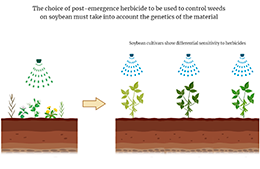Selectivity of latifolicides associated with glyphosate applied in post-emergence on soybean cultivars
DOI:
https://doi.org/10.48162/rev.39.098Palabras clave:
Control químico, Glycine max, herbicidas, malezasResumen

The genetic improvement of soybean cultivars over the years has focused on increasing the yield capacity and tolerance to some abiotic and biotic factors, such as drought, diseases, and pests. However, during the transfer of genes of interest, some genes responsible for a lower tolerance to herbicides can be integrated into the genome of the new cultivar. Thus, tests designed to assess the tolerance of these new soybean cultivars to herbicides are needed to avoid yield losses caused by poisoning after application. The objective of this study was to evaluate the selectivity of herbicides associations applied in post-emergence of three soybean cultivars. The experimental design used was a randomized complete block, with four replications. The selected cultivars were M7110 IPRO®, Foco IPRO®, and Bônus IPRO®. The herbicides and the respective doses (g a.i. ha-1) used were: glyphosate (960), glyphosate + bentazon (960 + 600), glyphosate + fomesafen (960 + 175), glyphosate + lactofen (960 + 120), glyphosate + imazethapyr (960 + 100), glyphosate + chlorimuron (960 + 10), glyphosate + cloransulam (960 + 39.5), and a control without herbicide application. The components of growth and yield evaluated were: height, stand, the weight of one hundred grains, and yield. A visual note of intoxication was also made for each treatment. The application of post-emergence herbicides does not alter the plant stand of soybean cultivars. Also, these herbicides were not reduced the yield of M7110 IPRO® and Foco IPRO® cultivars. Both glyphosate isolated and mixed with lactofen or imazethapyr reduced yield of Bônus IPRO® cultivar.
Highlights
- Herbicide associations applied post-emergence cause higher levels of injuries on soybean crop.
- The visualization of injuries resulting from herbicides on soybean does not necessarily imply yield reductions.
- The genetics of the soybean cultivar is decisive for the response in terms of sensitivity to herbicides.

Descargas
Publicado
Número
Sección
Licencia
Derechos de autor 2018 Revista de la Facultad de Ciencias Agrarias UNCuyo

Esta obra está bajo una licencia internacional Creative Commons Reconocimiento-NoComercial-CompartirIgual 3.0.
Aquellos autores/as que tengan publicaciones con esta revista, aceptan las Políticas Editoriales.



